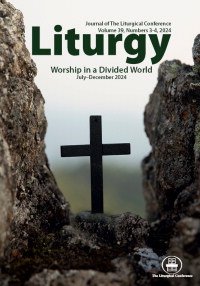In the Current Issue: "Preaching in a Politically Divided Congregation" (Part 1)
The issue of Liturgy entitled “Worship in a Divided World,” guest-edited by Benjamin Durheim, seeks to explore where our worshipping communities stand with regard to divisions that have pulled Christian worship patterns in divergent directions both negatively and, especially in recent times, positively as strengths. This excerpt is by homiletician Leah Schade who writes about preaching difficult subjects, encouraging honesty about politically contentious issues rather than avoiding them and thus neglecting to demonstrate the relevance of the biblical witness to contemporary life. –– Melinda Quivik
~ ~ ~ ~ ~
Swiss Reformed theologian Karl Barth famously exhortated preachers to “preach with the Bible in one hand and the newspaper in the other.” His words were intended to encourage ministers to attend to the contemporary issues of their time as they exegete the Word of God for their congregations. Biblical interpretation must have something to say to people who are wrestling with how to live in community given the societal and systemic struggles that affect their lives. It follows, then, that a congregation gathered for worship should anticipate a sermon that will help them to make sense of the world, find meaning in their day-to-day toils, strive toward their best selves, strengthen their faith, and elevate their hope.
But the divisive nature of red state/blue state politics in the United States in the early years of the twenty-first century, as in other eras, poses a significant challenge to congregations and clergy. The newspaper—more often now a screen—shows us a society that appears to be simultaneously blowing up and breaking down. The corrosive trend of polarized politics often catches churches in a fight, flight, or freeze dilemma that threatens the Body of Christ and the witness of the gospel.
How can ministers effectively navigate the sensitive task of addressing social issues that affect the lives of their congregants and people in their communities without exacerbating divisions or jeopardizing their standing of trust? Is it even feasible for them to deliver sermons addressing contemporary issues in a society so deeply fractured and politically bifurcated? And if the minister and gathered assembly choose to wade into these fraught waters, how might liturgy help frame and support such a task?
In this article, I’ll share findings from research that my team and I have been conducting from 2017 to 2023 about ministry, preaching, and social issues that will provide a bird’s eye view of what preaching in this divisive time has been like for clergy and congregations. Then I’ll describe a method I’ve developed for preaching in a politically divided congregation called the sermon-dialogue-sermon process. I’ll conclude with some suggestions about the ways in which liturgical practices and rituals can scaffold and enhance preaching in a divided congregation.
Finding the “purple zone” in various politically divided settings has shaped much of my life and ministry. I was raised in a Republican household in the 1970s and 80s but shifted to a more centrist position during college in the early 1990s. By the time I finished my M.Div. degree and began pastoring in 2000, I came to fully embrace a progressive Christian position. Yet the churches I have served spanned the red-purple-blue spectrum. So, I’ve had to learn (with mistakes along the way) how to pastor, preach, and lead worship with people who have very different values and commitments from each other and from my own.
~ ~ ~ ~ ~
Leah D. Schade is Associate Professor of Preaching and Worship at Lexington Theological Seminary in Kentucky and author of Preaching in the Purple Zone: Ministry in the Red-Blue Divide (Rowman & Littlefield/Alban Books, 2019). She is the EcoPreacher blogger for Patheos.
Leah D. Schade, “Liturgical Framing for Preaching in a Politically Divided Congregation,” Liturgy 39, nos. 3–4 (2024): 132–141, https://doi.org/10.1080/0458063X.2024.2369032.
